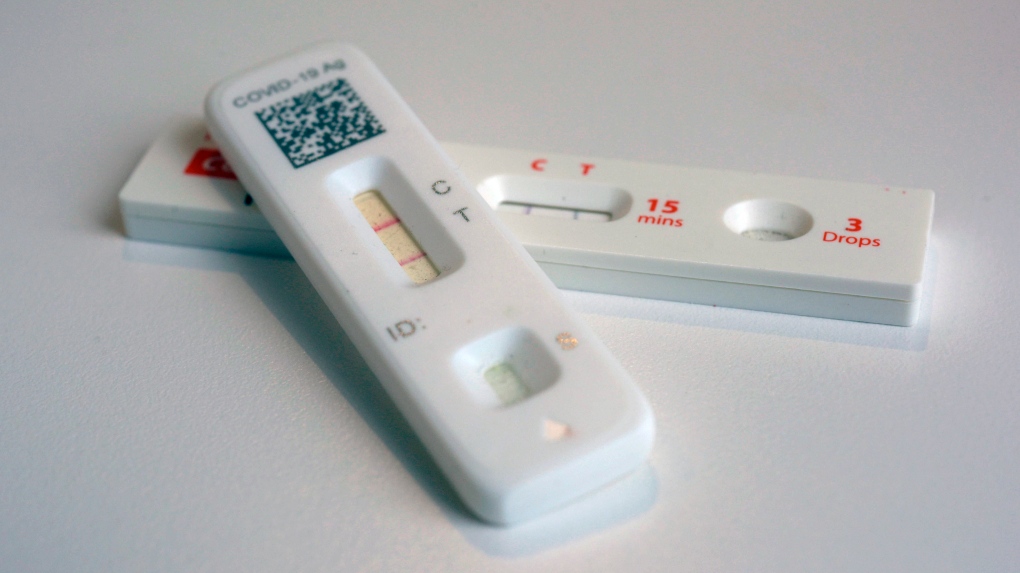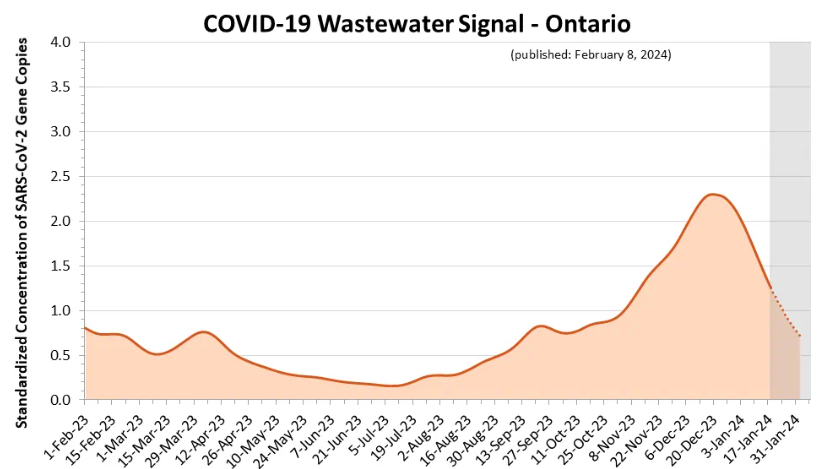Ontario's COVID-19 wastewater data shows infection rate headed in 'the right direction'
 In this file photo, COVID-19 antigen home tests indicating a positive result are photographed in New York, April 5, 2023. (AP Photo/Patrick Sison, File)
In this file photo, COVID-19 antigen home tests indicating a positive result are photographed in New York, April 5, 2023. (AP Photo/Patrick Sison, File)
A snapshot of Ontario’s COVID-19 wastewater data shows the rate of infection in the province is dropping after a holiday spike.
According to Ontario Public Health’s last update, the province’s so-called wastewater signal was 0.71 as of Feb. 2 -- the lowest level since Sept. 14. In the second half of December, during what some public health experts described as a wave of infection, the marker reached 2.29.
- Download our app to get local alerts on your device
- Get the latest local updates right to your inbox
“We had a spike in wastewater detection of COVID, throughout December, and in January, and then it started to decline after the holiday season and certainly continues to head in the right direction,” University Health Network Infectious Disease Specialist Dr. Isaac Bogoch told CTV News Toronto on Monday.
The presence of COVID-19 in wastewater appears to be shrinking in every region surveyed by Ontario Public Health, with the exception of northwest Ontario where the signal is actually trending upward to 1.28.
While promising, wastewater data only shows a part of the province’s COVID-19 picture, Bogoch warns.
“If the question is: how are we doing with COVID? The answer is: you've got to look at multiple metrics, right? Because no one metric is perfect, including wastewater,” he explained, adding that factors like hospitalizations, test positivity and number of tests completed help to add context.
Although Ontario no longer tests for or reports on COVID-19 infections as it did during 2020 and 2021, the publicly available data shows other key indicators are trending down as well.
 Ontario's COVID-19 wastewater data is seen in this image. (Public Health Ontario)
Ontario's COVID-19 wastewater data is seen in this image. (Public Health Ontario)
As of Feb. 3, there were 81 people in hospital with the virus compared to 396 hospitalizations at the beginning of December. Meanwhile, test positivity is dropping from a recent high of 43.1 per cent in late November to 21.5 per cent in the last week of January.
Even though the data is “far from perfect,” Bogoch says piecing it all together does help show how prevalent COVID-19 is in the province, especially at a time when testing and reporting is not nearly as widespread as it once was.
“But when you put all the pieces together, even though they are imperfect bits of data, it paints a picture, and that picture is COVID is still here. COVID is still a problem. But we're seeing much less COVID circulating now than what we were during the holiday season,” he said.
CTVNews.ca Top Stories

'They thought he wasn't making it': B.C. soccer star's family on his shocking shooting — and remarkable recovery
Born and raised in Metro Vancouver, Nathan Demian was living his dream playing soccer for top-ranked Ohio State University, when he was shot during a post-game pizza run with his brother Saturday night.
MPs approve $21.6B in supplementary spending; Conservatives vote against
Parliament has approved $21.6 billion in government spending, in a late Tuesday vote in the House of Commons.
No injuries reported after gunshots fired inside Etobicoke high school, 2 suspects outstanding
Toronto police are searching for two suspects after gunshots were fired inside an Etobicoke high school late Tuesday afternoon.
DEVELOPING Luigi Mangione shouts as he is led into courthouse where he contests extradition to N.Y.
The suspect in the killing of UnitedHealthcare’s CEO struggled with deputies and shouted Tuesday while arriving for a court appearance in Pennsylvania, a day after he was arrested at a McDonald’s and charged with murder.
Celebrities and coastal residents flee from wind-driven wildfire in Malibu
Evacuation orders and warnings have gone out to 20,000 Southern California residents Tuesday as firefighters battled a wind-driven wildfire in Malibu that burned near celebrities' seaside mansions, horse farms and Pepperdine University, the sheriff's department said.
Waterloo Region mistakenly applied $13.7M discount to Amazon build in Blair
The Region of Waterloo will not be able to demand $13.7 million from a developer after they said a discount was mistakenly issued for the development of an Amazon fulfillment centre.
Dolly Parton explains why her longtime husband doesn't attend events with her
Dolly Parton has been married for 58 years, but you probably could count on one hand the times you have seen her with her husband.
'Which one of those two is going to win?': Poilievre prods Trudeau, Freeland over spending tension
Revived talk of tensions between Prime Minister Justin Trudeau and Deputy Prime Minister and Finance Minister Chrystia Freeland prompted new questions Tuesday, about how big the federal deficit will be in next week's economic update.
Ex-minister cites 'threat to security' for denying emergency passport to Abdelrazik
Former foreign minister Lawrence Cannon says he denied an emergency passport to Abousfian Abdelrazik in 2009 because he considered the Montreal man a possible threat to national security.


































